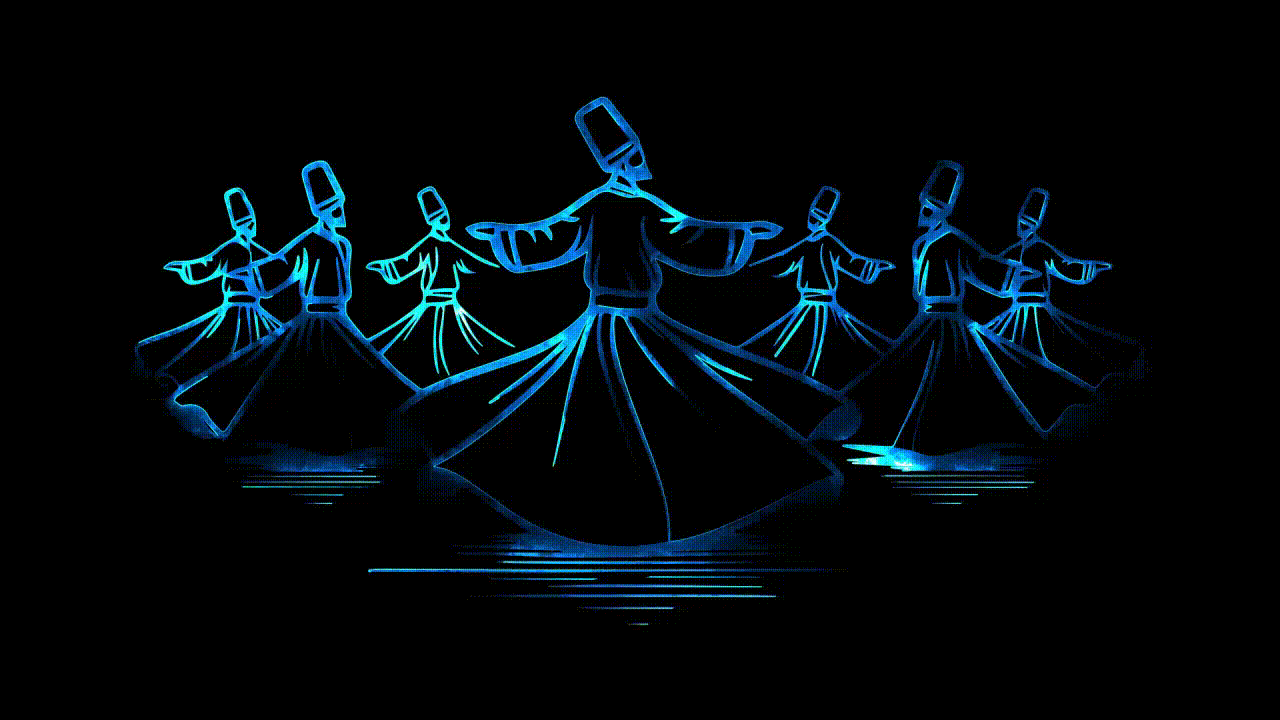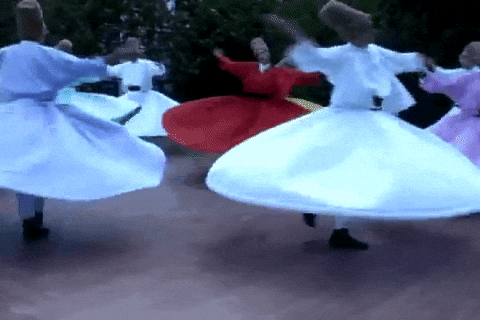AI Musical Composition 15
by RebeJumper on RebeJumper
View my bio on Blurt.media: https://blurt.media/c/melodyliterary 
Music is also connected to culture, mysticism, art, food, various ceremonies, beliefs, and religion. This time, the song you can hear reflects an ancient connection that exists among various communities with Islamic traditions.
The Sufi Whirling Dervish dance, also known as the Sema ceremony, is a captivating spiritual practice rooted in the mystical traditions of Sufism, a branch of Islam that emphasizes the inner path to divine love and knowledge through direct personal experience of God.

Origins in Sufism
The Whirling Dervish dance originates from the teachings of Jalāl ad-Dīn Muhammad Rūmī (1207–1273), the famous Persian poet, Islamic scholar, and Sufi mystic. Rumi believed in the power of music, poetry, and dance as a path to union with the divine. His followers, known as Mevlevi dervishes, institutionalized his teachings into a formal spiritual order in Konya, in present-day Turkey.
The Dance as a Spiritual Practice
The Sema ceremony is not merely a dance; it is a sacred ritual that symbolizes the soul’s journey toward God. Dervishes wear symbolic clothing:
A white gown representing the burial shroud,
A black cloak symbolizing the grave,
A tall felt hat (sikke) representing the tombstone of the ego.

The dance begins with the removal of the black cloak, signifying spiritual rebirth. The dervishes then spin in repetitive circles, typically counterclockwise, with one hand raised to the sky (to receive divine grace) and the other pointing to the earth (to channel that grace to the world). This turning is both physical and metaphysical: a reflection of the movement of the planets and the surrender of the ego to the love of God.
Symbolism of the Whirling
The whirling itself is deeply symbolic. It reflects: The rotation of the universe—everything, from atoms to galaxies, turns. The annihilation of the ego (fana) and the journey toward divine unity. The cycle of death and rebirth, as the dervish spins out of his material self and into spiritual enlightenment.
Historical Development
The Mevlevi Order became influential in Ottoman society and was officially supported for centuries. Their ceremonies were both spiritual and cultural events. However, in 1925, under the secular reforms of Mustafa Kemal Atatürk, Sufi orders were banned in Turkey. The Whirling Dervishes went underground for a time, but the dance survived as both a spiritual ritual and a cultural performance.
In 1954, the Turkish government began allowing the Sema ceremony to be performed publicly, though mostly as a tourist and cultural display. In 2005, UNESCO declared the Mevlevi Sema Ceremony a Masterpiece of the Oral and Intangible Heritage of Humanity.
https://x.com/AndyZa9/status/1787305237507723717
Contemporary Practice
Today, the Whirling Dervish dance continues to be practiced both as a sacred rite by followers of Rumi’s spiritual path and as a cultural symbol of Turkish heritage. While some view the public performances as a dilution of the original spiritual essence, others see them as a bridge connecting the mystical and modern worlds.
The Sufi Whirling Dervish dance is more than an artistic expression—it is a meditative journey, a form of prayer, and a poetic embodiment of surrender to divine love. Its enduring legacy speaks to the universal human longing for transcendence, unity, and inner peace.
The word "dervish" (from Persian darvīsh, meaning "one who seeks doors") refers to a member of a Sufi order—a mystic branch within Islam focused on the inward search for God and the renunciation of worldly pleasures. Dervishes are often associated with spiritual poverty, humility, and deep devotion, living simple lives in pursuit of divine truth.
Origins of the Dervishes
The roots of the dervish tradition lie in the early centuries of Islam, particularly from the 8th to the 12th centuries, when Islamic mysticism (later known as Sufism) began to take shape. Sufism emerged as a response to what some Muslims saw as the growing materialism and rigid legalism of mainstream religious practice. These early mystics sought a more direct, personal experience of God, emphasizing inner purification, asceticism, and divine love.
The Qur'an and the teachings of the Prophet Muhammad—especially those emphasizing love, mercy, humility, and detachment from materialism—formed the spiritual foundation for these mystics. Over time, they formed Sufi brotherhoods, or tariqas, each following the teachings of a founding master (or shaykh/pir). From these brotherhoods arose the dervishes, who were dedicated followers of the Sufi path.
Life and Practice of the Dervish
Dervishes often live communally in tekke (lodges) or khanqah (retreat houses), where they dedicate themselves to spiritual practices, including:
Dhikr (remembrance of God through chanting or recitation), Meditation, music, and poetry. Service to others as a form of devotion. Poverty and detachment from material wealth. Their way of life mirrors the Sufi ideal of becoming "nothing" in order to be filled with God’s presence—a state referred to as fana (the annihilation of the ego).
Famous Sufi Orders and Dervish Branches
Several important Sufi orders have produced dervishes, each with distinct rituals and teachings. Some of the most notable include:
The Mevlevi Order: Founded in Konya, Turkey, by the followers of Jalāl ad-Dīn Rūmī. They are best known for the whirling dervish dance (Sema), which is both a meditative and symbolic act of spiritual ascent.
The Qadiriyya: One of the oldest Sufi orders, founded by Abd al-Qadir al-Jilani in Baghdad. Known for their emphasis on charity, spiritual discipline, and public preaching.
The Naqshbandiyya: Known for silent dhikr and strict adherence to Islamic law. This order spread widely across Central Asia, Turkey, and South Asia.
The Chishtiyya: Flourished in South Asia, especially India, and emphasized music (qawwali), love, and openness to people of all backgrounds.

Cultural and Spiritual Influence
Dervishes played a significant role in the spread of Islam, especially in regions like Anatolia, Central Asia, and the Indian subcontinent. Their poetry, music, and inclusive spirituality helped bridge cultural gaps and offered a mystical dimension to the Islamic faith that resonated across societies. They have also influenced literature, philosophy, and art—Rumi's verses, for example, have become universal symbols of divine love and human longing.
Dervishes Today
In modern times, dervish orders continue to exist, though many face challenges due to secularization, political repression, or misunderstanding of their role. In some countries, their public ceremonies have been restricted or transformed into cultural performances. Nevertheless, the spiritual legacy of the dervishes remains vibrant. Their teachings of compassion, love, and humility are still deeply relevant in a world often marked by division and materialism.
The dervishes are the spiritual seekers of the Islamic world, rooted in the rich traditions of Sufism. Their lives are dedicated to the pursuit of divine truth, not through external doctrines, but through the transformation of the heart. Their path reminds humanity that the way to God lies not in power or possessions, but in surrender, silence, and love.
https://x.com/Rainmaker1973/status/1924018790364315923
🎶🎶🎶
Songs evoke emotions, sometimes the silence of words is enough while the musical notes take shape and life, however, there can also be a poem that accompanies the message... like this one:
Turning Silenc
In circles drawn upon the floor,
a whisper stirs, then nothing more
a robe unfurls, a shadow sways,
the soul begins to drift and blaze.
Bare feet kiss earth in quiet grace,
a single axis, time and space.
One hand to sky, the other low,
as if to catch the stars below.
Eyes half closed, the breath a thread,
the self dissolves, the edges shed.
No past, no name, no weight, no skin
just motion echoing within.
Each turn a tear the spirit weeps,
each spin a seed the silence keeps.
No destination, no demand,
just air and dust and outstretched hand.
Around, around, the stillness swirls,
beneath the layers, truth unfurls
not shouted loud, nor carved in stone,
but felt when all the rest is gone.
So let the body fall away,
and let the mind forget the day.
For what remains, no tongue can speak
a silence only motion seeks.